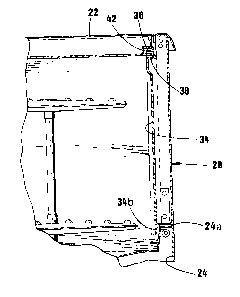Some of the information on this Web page has been provided by external sources. The Government of Canada is not responsible for the accuracy, reliability or currency of the information supplied by external sources. Users wishing to rely upon this information should consult directly with the source of the information. Content provided by external sources is not subject to official languages, privacy and accessibility requirements.
Any discrepancies in the text and image of the Claims and Abstract are due to differing posting times. Text of the Claims and Abstract are posted:
| (12) Patent: | (11) CA 1333987 |
|---|---|
| (21) Application Number: | 1333987 |
| (54) English Title: | GASKETLESS DOOR FOR DISHWASHERS |
| (54) French Title: | PORTE DE LAVE-VAISSELLE SANS GARNITURE D'ETANCHEITE |
| Status: | Expired and beyond the Period of Reversal |
| (51) International Patent Classification (IPC): |
|
|---|---|
| (72) Inventors : |
|
| (73) Owners : |
|
| (71) Applicants : | |
| (74) Agent: | |
| (74) Associate agent: | |
| (45) Issued: | 1995-01-17 |
| (22) Filed Date: | 1989-02-08 |
| Availability of licence: | N/A |
| Dedicated to the Public: | N/A |
| (25) Language of filing: | English |
| Patent Cooperation Treaty (PCT): | No |
|---|
| (30) Application Priority Data: | None |
|---|
A dishwashing machine having a box-like closed main frame
with a front vertical opening and a door for closing the front
opening. A hinge pivotally interconnects the bottom edge section
of the door to the bottom front edge section of the main frame. A
latch releasably lockingly anchors the top edge section of the door
to the top front edge section of the main frame. The machine is
characterized by the way the door joins with the main frame of the
dishwasher when the door is closed: the side and top edge sections
of the door inner face have two spaced outturned projections
forming a continuous U-shape cavity, and the front and side edge
sections of the top and side walls of the dishwasher main frame
define an inturned U-shape cavity. The U-shape cavities engage
each other when the door is closed, to prevent water escape but to
allow air circulation through the joint.
Note: Claims are shown in the official language in which they were submitted.
Note: Descriptions are shown in the official language in which they were submitted.

2024-08-01:As part of the Next Generation Patents (NGP) transition, the Canadian Patents Database (CPD) now contains a more detailed Event History, which replicates the Event Log of our new back-office solution.
Please note that "Inactive:" events refers to events no longer in use in our new back-office solution.
For a clearer understanding of the status of the application/patent presented on this page, the site Disclaimer , as well as the definitions for Patent , Event History , Maintenance Fee and Payment History should be consulted.
| Description | Date |
|---|---|
| Time Limit for Reversal Expired | 2010-01-18 |
| Inactive: Adhoc Request Documented | 2009-10-21 |
| Letter Sent | 2009-01-19 |
| Commissioner's Decision to Refuse | 2004-01-30 |
| Letter Sent | 2004-01-05 |
| Small Entity Declaration Determined Compliant | 2003-12-08 |
| Inactive: Office letter | 2000-12-04 |
| Inactive: Office letter | 2000-12-04 |
| Revocation of Agent Requirements Determined Compliant | 2000-12-04 |
| Grant by Issuance | 1995-01-17 |
There is no abandonment history.
| Fee Type | Anniversary Year | Due Date | Paid Date |
|---|---|---|---|
| MF (category 1, 3rd anniv.) - small | 1998-01-20 | 1997-12-23 | |
| MF (category 1, 4th anniv.) - small | 1999-01-18 | 1999-01-07 | |
| MF (category 1, 5th anniv.) - small | 2000-01-17 | 1999-12-22 | |
| MF (category 1, 6th anniv.) - small | 2001-01-17 | 2000-12-18 | |
| MF (category 1, 7th anniv.) - small | 2002-01-17 | 2001-12-20 | |
| MF (category 1, 8th anniv.) - small | 2003-01-17 | 2002-10-30 | |
| MF (category 1, 9th anniv.) - small | 2004-01-19 | 2003-12-08 | |
| MF (category 1, 10th anniv.) - small | 2005-01-17 | 2004-12-24 | |
| MF (category 1, 11th anniv.) - small | 2006-01-17 | 2005-11-14 | |
| MF (category 1, 12th anniv.) - small | 2007-01-17 | 2006-11-28 | |
| MF (category 1, 13th anniv.) - small | 2008-01-17 | 2007-11-16 |
Note: Records showing the ownership history in alphabetical order.
| Current Owners on Record |
|---|
| JEAN ARCHAMBAULT |
| Past Owners on Record |
|---|
| None |